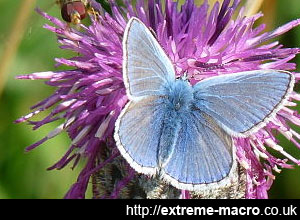Know Your Subject
by Johan J Ingles-Le Nobel
Last updated August 31, 2017
As extreme macro photographers, one of the main subjects that we will tend to shoot will be insects, and knowing your subject can be the difference between getting a great shot or taking a mundane pic.
Like all creatures insects have behavioural habits, and by knowing your subject I find that this helps me predict what they're going to do or where they're going to be, so it makes getting a decent shot all the more likely.

A common blue, which loves to huddle in a group with its friends when they sleep.
By knowing your subject I find that this helps me predict what they're going to do or where they're going to be, so it makes getting a decent shot all the more
Timing
Being cold-blooded, mornings are an especially good time to find sluggish, sleeping insects. They need sunlight to warm up, so before those morning rays of sunshine start warming your subjects up is an ideal time.
For example, butterflies. When I started I would chase butterflies all over the place during the hottest part of the day. I discovered that this is a somewhat useless exercise as butterflies fly around 90% of the time and spend a few seconds here and there feeding.
Much better to get up early and look for sleeping butterflies, and by knowing your subject it will give you a headstart. For example Common Blue butterflies sleep in colonies, so you will often see several on the same plant. Cool (6-10 C) and dewy work very well.
insects usually return to their favourite perch so wait rather than chaseMany wild things (birds, animals, insects etc) will let you take better images if you just hang around the area long enough to become a normal part of their environment. The best way is to set up and then wait for the insects to come to you - insects usually return to their favourite perch so wait rather than chase.
Know Insect Foods
It should be obvious that to photograph an insect, knowing their food is a great advantage, and knowing when they're likely to be feeding even more so. Moths, for example, can often be seen at certain flowers, hovering around just after twilight in Spring. Alternatively, use bait to attract insects.
Study
There isn't such a thing as a guide to insect behaviour for macro photographers, but there are a wealth of books and websites around that go into insects and their behaviour. Read round your subject and you'll soon start picking up the information that you need.
Related Articles





